October, 1962

Model Airplane News Cover for October, 1962
Control Line Scale B-25
Click to Enlarge
Here is what the blurb about the cover has to say:
"...Editor's [Walter Scroder] number one son receives acheery wave from Art Director's very charming daughter Anne. Both flew up to Harrisburg, Pa. for cover photo of Florian "Perk" Piorkowski's scale B-25 featured in this issue. Anne is standing behind a Piper Commanche ownerd by Gene Hooker, MAN's cover photographer ..."
NOTE: By coincidence or intent, Piorkowski's super scale model of a Piper Commanche was on the cover of the June, 1962 issue. This is the first, but not the last cover in which Schroder put himself or his relatives on the cover. Neither McGehee nor Winter ever did this.
About the Model
This control-line scale model at 7/8" to the foot is a big one. It weighs 16 pounds and is powered by two K&B 0.45 engines. It has won an impressive array of trophies. With all the time and money invested in the model, it is almost incredible that Piorkowski would fly it regularly. As of April, 1962 it had won eight trophies.
You may read the article by clicking to enlarge the following photos:

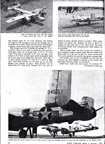

Florian Piorkowski Super Scale Model B-25
Click to Enlarge
About the Full Size Airplane


North American B-25 "Mitchell"
Model Airplane News Cover Art for August, 1942 and September, 1957
by Jo Kotula
Click to Enlarge
The North American B-25 Mitchell was an American twin-engined medium bomber manufactured by North American Aviation. It was used by many Allied air forces, in every theater of World War II, as well as many other air forces after the war ended, and saw service across four decades. It was named in honor of General Billy Mitchell, a pioneer of U.S. military aviation. (The B-25 is the only American military aircraft named after a specific person.) About 10,000 B-25s in numerous models were built.
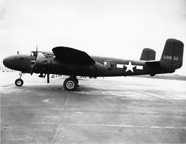
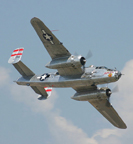

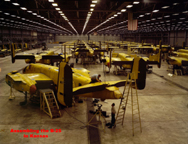
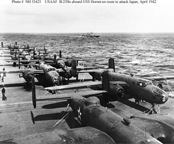
North American B-25 "Mitchell"
Click to Enlarge
The B-25 was a descendant of the earlier XB-21 project of the mid-1930s. Experience gained in developing that aircraft was eventually used by North American in a new project called the NA-40 which was submitted to the United States Army Air Corps as an attack bomber for export to the United Kingdom and France. However, those countries chose the Douglas DB-7 (aka A-20 Havoc). Despite this loss of sales, the NA-40B re-entered the spotlight when the Army Air Corps evaluated it for use as a medium bomber. Due to the pressing need for medium bombers by the Army, no experimental or service-test versions were built. Any necessary modifications were made during production runs, or to existing aircraft at field modification centers around the world. A total of 6,608 B-25s were built
As noted on the August, 1942 cover, the B-25 first gained fame for its part in the Doolittle Raid, in which sixteen B-25Bs led by the legendary Lieutenant Colonel Jimmy Doolittle, attacked mainland Japan four months after the bombing of Pearl Harbor. The mission gave a much-needed lift in spirits to the Americans, and alarmed the Japanese who had believed their home islands were inviolable by enemy troops. While the amount of actual damage done was relatively minor, it forced the Japanese to divert troops for the home defense for the remainder of the war.
Because of the urgent need for hard-hitting strafer aircraft, a version dubbed the B-25G was developed, in which the standard-length transparent nose and the bombardier were replaced by a shorter solid nose containing two fixed .50 in machine guns and a 75 mm M4 cannon, one of the largest weapons fitted to an aircraft. The cannon was manually loaded and serviced by the navigator. The final version of the Mitchell, the B-25J, had a a solid nose containing eight .50 machine guns. Some B-25J variants carried 18 .50 caliber guns: eight in the nose, four in under-cockpit packages, two in an upper turret, two in the waist, and a pair in the tail. No other bomber of World War II carried as many guns
.The Mitchell was an amazingly sturdy aircraft and could withstand tremendous punishment. One well-known B-25C of the 321st Bomb Group was nicknamed "Patches" because its crew chief painted all the aircraft's flak hole patches. By the end of the war, this aircraft had completed over 300 missions, was belly-landed six times and sported over 400 patched holes. The airframe was so bent, straight-and-level flight required 8° of left aileron trim and 6° of right rudder, causing the aircraft to "crab" sideways across the sky.
In a note more realevant to the 21st Century: On Saturday, July 28, 1945, while flying in thick fog, a USAAF B-25D crashed into the north side of the Empire State Building, hitting between the 79th and 80th floor. Fourteen people were killed — 11 in the building, along with the occupants of the bomber. It was partly because of this incident that towers 1 and 2 of the World Trade Center were designed to withstand the impact of a Boeing 707 aircraft, the largest plane flying at the time of the buildings' construction. The problem of aircraft hitting skyscrapers had been analyzed in basic civil engineering texts for some time, and the terrorists of 9-11 knew that they had to use aircraft larger than the 707 to bring the trade towers down.
Here is a video of the B-25 "Mitchell":
In addition to the cover of Model Airplane News, this airplane was also featured in the WINGS "Friend or Foe" trading card series of the early 1950s
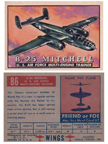
Trading card representation of the North American B-25 "Mitchell"
Click Here to see all 200 cards in the series
Click to Enlarge
Click Here for more information about the North American B-25 "Mitchell".

Click to go back and select another cover.
Counter for the Entire Site (not just this page..)
Home | About Lindy | Last Week's Reviews | Upcoming Events | 1940s Collecibles
The Guide - Establishments - Travel - Accessories
Music | Links | Photo Gallery | Extras | Contact